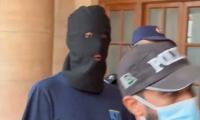Never before in our history have we witnessed an enemy such as this. The invisible enemy is a tiny molecular ball with spikes protruding from it. It is these spikes that get attached to human cells, penetrate them and the virus then takes over the cells multiplication mechanism, reproducing itself and invading various human organs from head to toe. The human immune system tries hard to fight off the invader, and either succeeds or the human being dies through the collapse of the lungs, heart, kidney, brain, blood vessels or other organs.
Understanding the manner in which the attack is taking place will provide clues regarding the drugs that may be used to help fight off the deadly invader. It has been observed that patients often develop a tendency of blood clotting, which can seriously aggravate the condition and lead to thrombosis and death. So blood thinners such as common aspirin may help in such cases.
The immune system also often responds viciously to defend the human body, and this overzealous immune response can have fatal consequences. Hence the use of immunosuppressive drugs is one treatment that is being actively explored. One mystery is that the oxygen level in patients drops significantly, providing clues regarding how this vicious enemy may be acting. Studies have shown that the virus attacks the hemoglobin in the blood, severely reducing its capacity to carry oxygen from the lungs to various parts of the body, leading to organ failure.
So what is going on? A brief analysis of the course of events is as follows. If you are near an infected person, and if he coughs, sneezes or even speaks to you, tiny virus laden droplets are expelled from the mouth of the infected person. Some of these may enter and find a welcome home in the lining of your nose and throat. The cells in these linings are rich in certain types of surface receptors (angiotensin-converting enzyme 2 (ACE2)). These receptors are essential to regulate blood pressure. The virus needs these receptors to get attached and then to enter the human cells. The virus cannot multiply on its own, but once inside the human cells, it hijacks the cells’ multiplication machinery and makes copies of itself and invades new cells.
In the initial first week period, no symptoms may be present but the infected person will be shedding copious amounts of the virus through coughing and sneezing, infecting others. The symptoms that may occur could include a fever, dry cough, sore throat, loss of smell and taste, or head and body aches. The human immune system is active at this point, sensing the virus structure, identifying the weak points in it and synthesizing an army of antibodies to fight against it. The fever and discomfort that the infected person experiences reflects the battle going on between the trillions of evil viruses and the good antibodies. If the army of antibodies wins, then you gradually recover and the invaders are fought off.
In about five percent of the patients, the antibodies fail and the condition of the patient becomes serious. In this phase the virus army marches down the windpipe to invade the lungs. It is here that it turns deadly. There are tiny air sacs (called alveoli) in the lungs that are lined with the ACE 2 receptors to which the virus gets attached through a kind of lock and key mechanism. It is through these air sacs that the oxygen that you have breathed into the lungs crosses into the tiny blood vessels (capillaries) that are besides these air sacs. This oxygen is then carried to various parts of the body. This healthy oxygen transfer is however disrupted by the war that is waging between the viruses and the antibodies.
The virus infected cells are killed by the immune cells leaving behind a stew of dead cells and fluid – pus. This results in pneumonia like symptoms including breathlessness, cough and fever. Some patients recover with assisted respiration but others deteriorate further. The air sacs get filled with mucus, white blood cells, fluid and the debris of destroyed lung cells, making them ineffective in their role for oxygen exchange, so that the oxygen levels in such patients drop sharply and they suffer from acute respiratory distress. At this stage ventilators are needed which may or may not be effective, depending on the damage done to the lungs. Meanwhile, the virus also invades other human organs such as kidneys, heart and brain leading to multiple organ failure and death.
While there has been much attention on the need for ventilators, there has been little discussion on another type of equipment that is needed in large numbers – dialysis machines. If patients are not dying of lung failure then a very large proportion are dying of renal failure. The kidneys are also rich in the ACE 2 receptors so loved by the coronavirus and they get happily attached there to cause havoc. According to one study in China, 27 percent of 85 hospitalised patients in Wuhan suffered from kidney failure. Diabetic patients or those with blood pressure were found to be particularly vulnerable to Covid-19. The brain and the central nervous system are also attacked by the virus.
So where do we stand today? Vaccines are at least a year away, although a group in Oxford is claiming that they will have one available in the market by next September. New drugs are out of the question as their development processes take from 5 to 10 years, and costs several billion dollars for research and development. Convalescent plasma is an option but it has not been tried on a large scale anywhere and its availability in the quantities needed is a serious problem. Use of stem cells is also being explored. A viable treatment option is to experiment with existing drugs and see if they can help in treatment. Certain Chinese traditional medicines based on herbs have been found to be effective and their use authorized by the Chinese government on the basis of clinical data.
There is a huge global effort underway with scientists and doctors working day and night to find a cure. Trials carried out in France with a combination of hydroxychloroquine and azithromycin have yielded positive results. Another drug, Remdesivir, has been shown recently to reduce the recovery period from an average of 15 days to 11 days in a clinical trial carried out on 1000 patients.
It appears that no single drug will eventually work against this virus, and that an armory of several drugs may need to be used to win this war. Our own national task force chaired by me is also involved in clinical trials, magnification of testing and genetic analysis so that we may better understand and play an effective role in this global effort. Clinical trials of some internationally developed vaccines is an area of particular focus. Our task force is also promoting the indigenous manufacture of ventilators, masks and other safety devices.
The writer is the former chairman of the HEC, and president of the Network of Academies of Science of OIC Countries (NASIC).
Email: ibne_sina@hotmail.com
Critics say legislation aims to suppress voices of active political opponents on social media
In medical terms, earlier patient is diagnosed, sooner they can be treated or even have their life saved
Flames and smoke rise from a line of trees as a wildfire burns at the Dadia National Park on the region of Evros,...
Another aspect of climate change vulnerability is its disproportionate impact on various sectors of society,...
Motorcyclists, who behave like rudderless missiles, pose immense traffic hazards to themselves and other motorists
Agencies like Unicef and the World Food Program continue to save lives around the globe







